service indicator CHEVROLET EXPRESS 1998 1.G Owners Manual
[x] Cancel search | Manufacturer: CHEVROLET, Model Year: 1998, Model line: EXPRESS, Model: CHEVROLET EXPRESS 1998 1.GPages: 386, PDF Size: 20.74 MB
Page 113 of 386
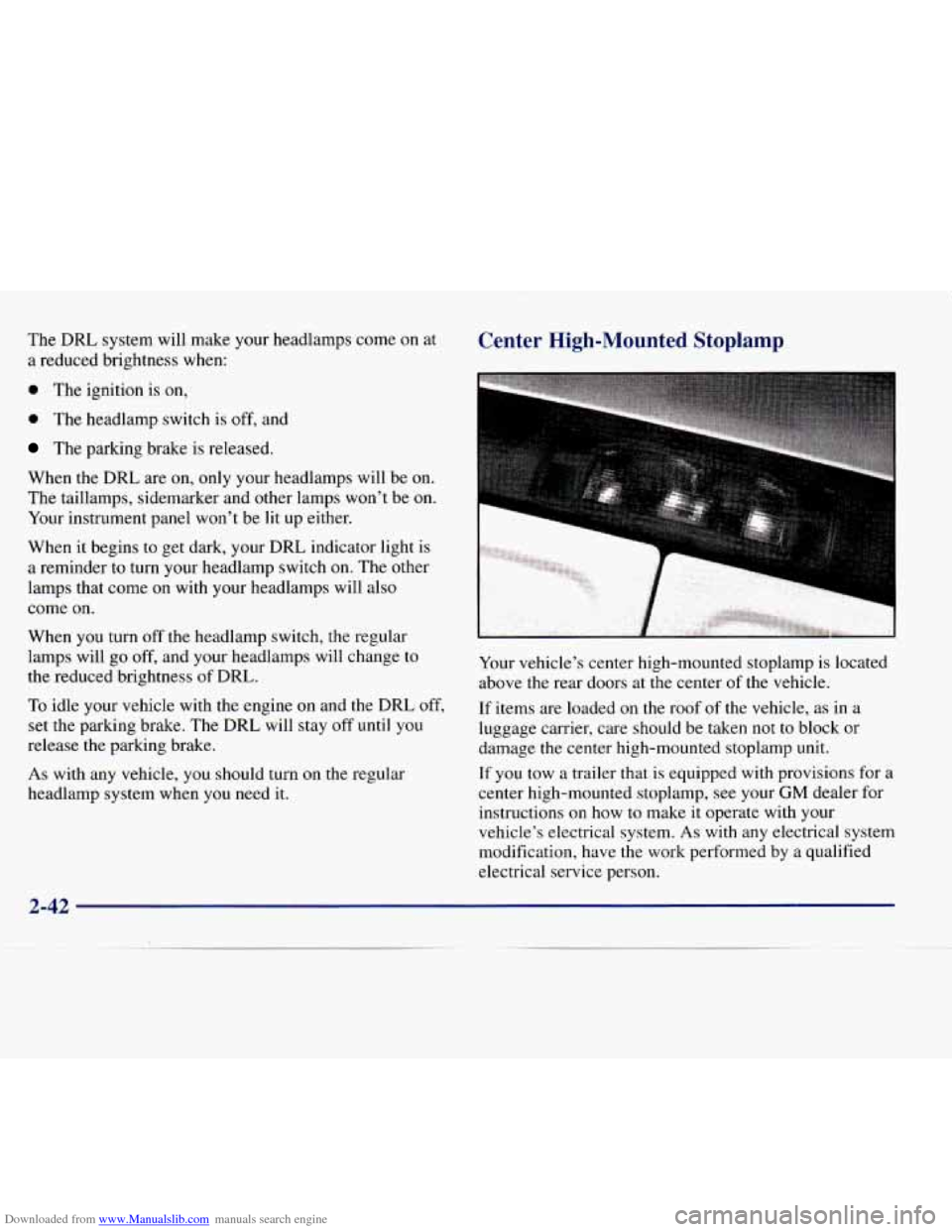
Downloaded from www.Manualslib.com manuals search engine The DRL system will make your headlamps come on at
a reduced brightness when:
0 The ignition is on,
0 The headlamp switch is off, and
The parking brake is released.
When the DRL are on, only your headlamps will be on.
The taillamps, sidemarker and other lamps won’t be on.
Your instrument panel won’t be lit up either.
When it begins to get dark, your
DRL indicator light is
a reminder to turn y,our headlamp switch on. The other
lamps that come
on with your headlamps will also
come on.
When you turn off the headlamp switch, the regular
lamps will go off, and your headlamps will change to
the reduced brightness of DRL.
To idle your vehicle with the engine on and the DRL off,
set the parking brake. The DRL will stay off until you
release
the parking brake.
As with any vehicle, you should turn on the regular
headlamp system when you need
it.
Center High-Mounted Stoplamp
Your vehicle’s center high-mounted stoplamp is located
above the rear doors at the center
of the vehicle.
If items are loaded
on the roof of the vehicle, as in a
luggage carrier, care should be taken not
to block or
damage the center high-mounted stoplamp unit.
If you tow a trailer that is equipped with provisions for
a
center high-mounted stoplamp, see your GM dealer for
instructions
on how to make it operate with your
vehicle’s electrical system. As with any electrical system
modification, have the work performed
by a qualified
electrical service person.
2-42
Page 129 of 386

Downloaded from www.Manualslib.com manuals search engine Malfunction Indicator Lamp (Service Engine Soon Light) (Gasoline Engine)
81 Your vehicle is equipped
SERVICE
ENGINE
I
SOON
with a computer which
monitors operation
of the
fuel, ignition and emission
control systems.
This system is called OBD I1 (On-Board
Diagnostics-Second Generation) and
is intended to
assure that emissions
are at acceptable levels for the life
of the vehicle, helping
to produce a cleaner
environment. The
SERVICE ENGINE SOON light
comes on to indicate that there
is a problem and service
is required. Malfunctions often will be indicated by the
system before any problem is apparent. This may
prevent more serious damage to your vehicle. This
system
is also designed to assist your service technician
in correctly diagnosing any malfunction.
NOTICE:
If you keep driving your vehicle with this light
on, after a while, your emission controls may not
work as well, your fuel economy may not be
as
good and your engine may not run as smoothly.
This could lead
to costly repairs that may not be
covered by your warranty.
This light should come on, as a check to show you it is
working, when
the ignition is on and the engine is not
running. If the light doesn’t come on, have it repaired.
This light
will also come on during a malfunction in one
of two ways:
0
0
Light Flashing -- A misfire condition has been
detected.
A misfire increases vehicle emissions and
may damage the emission control system
on your
vehicle.
GM or qualified service center diagnosis
and service may be required.
Light On Steady -- An emission control system
malfunction has been detected on your vehicle.
GM
or qualified service center diagnosis and service may
be required.
2-58
Page 161 of 386
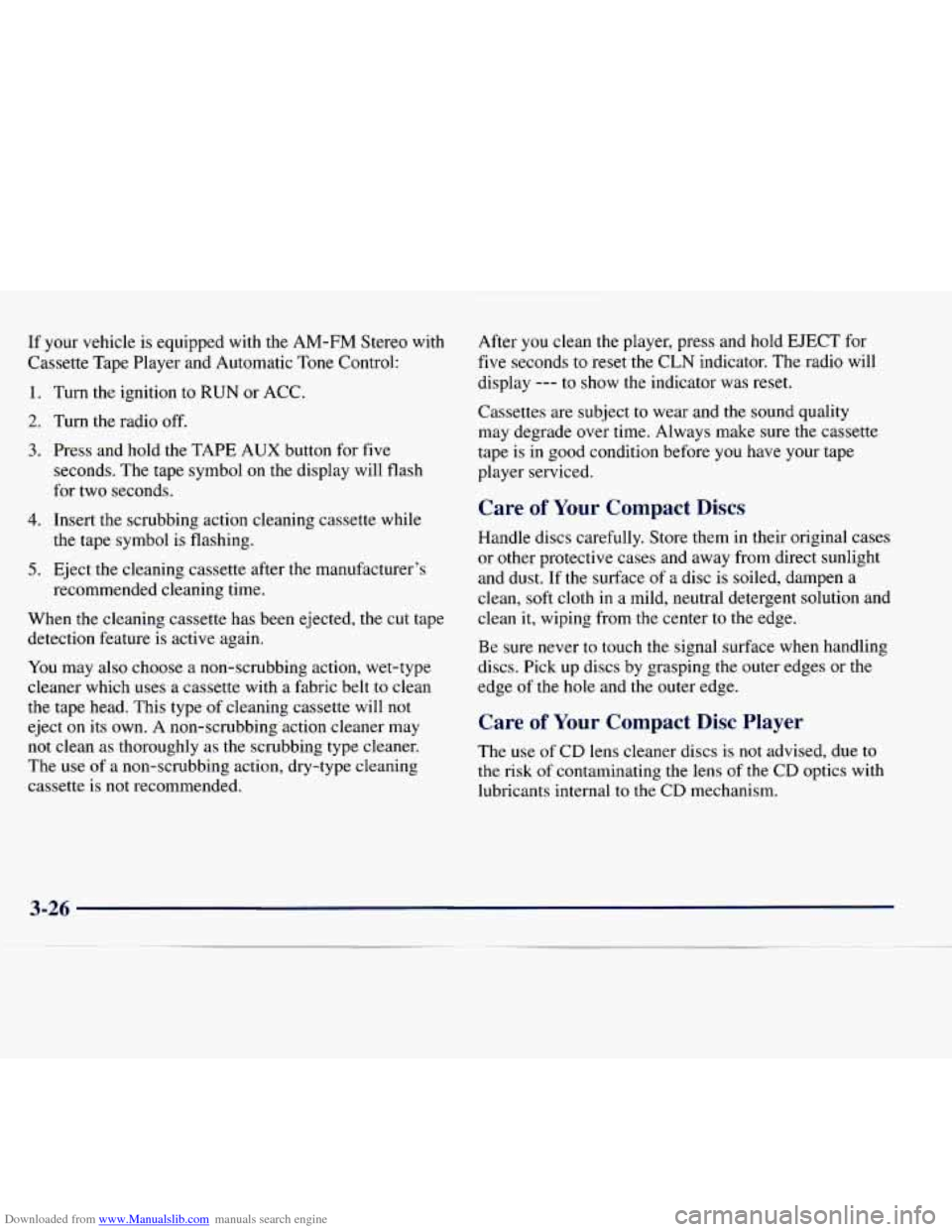
Downloaded from www.Manualslib.com manuals search engine If your vehicle is equipped with the AM-FM Stereo with
Cassette Tape Player and Automatic
Tone Control:
1. Turn the ignition to RUN or ACC.
2. Turn the radio off.
3. Press and hold the TAPE AUX button for five
seconds. The tape symbol
on the display will flash
for two seconds.
4. Insert the scrubbing action cleaning cassette while
the tape symbol is flashing.
5. Eject the cleaning cassette after the manufacturer’s
recommended cleaning time.
When the cleaning cassette has been ejected, the cut tape
detection feature
is active again.
You may also choose a non-scrubbing action, wet-type
cleaner which uses a cassette with
a fabric belt to clean
the tape head. This type of cleaning cassette will not
eject on its own. A non-scrubbing action cleaner may
not clean as thoroughly as the scrubbing type cleaner.
The use
of a non-scrubbing action, dry-type cleaning
cassette
is not recommended. After you
clean the player, press and hold EJECT for
five seconds to reset the
CLN indicator. The radio will
display
--- to show the indicator was reset.
Cassettes are subject to wear and the sound quality
may degrade over time. Always make sure the cassette
tape is in good condition before
you have your tape
player serviced.
Care of Your Compact Discs
Handle discs carefully. Store them in their original cases
or other protective cases and away from direct sunlight
and dust. If the surface
of a disc is soiled, dampen a
clean, soft cloth in a mild, neutral detergent solution and
clean it, wiping from the center to the edge.
Be sure never to touch the signal surface when handling
discs. Pick up discs by grasping the outer edges
or the
edge
of the hole and the outer edge.
Care of Your Compact Disc Player
The use of CD lens cleaner discs is not advised, due to
the risk
of contaminating the lens of the CD optics with
lubricants internal
to the CD mechanism.
Page 243 of 386
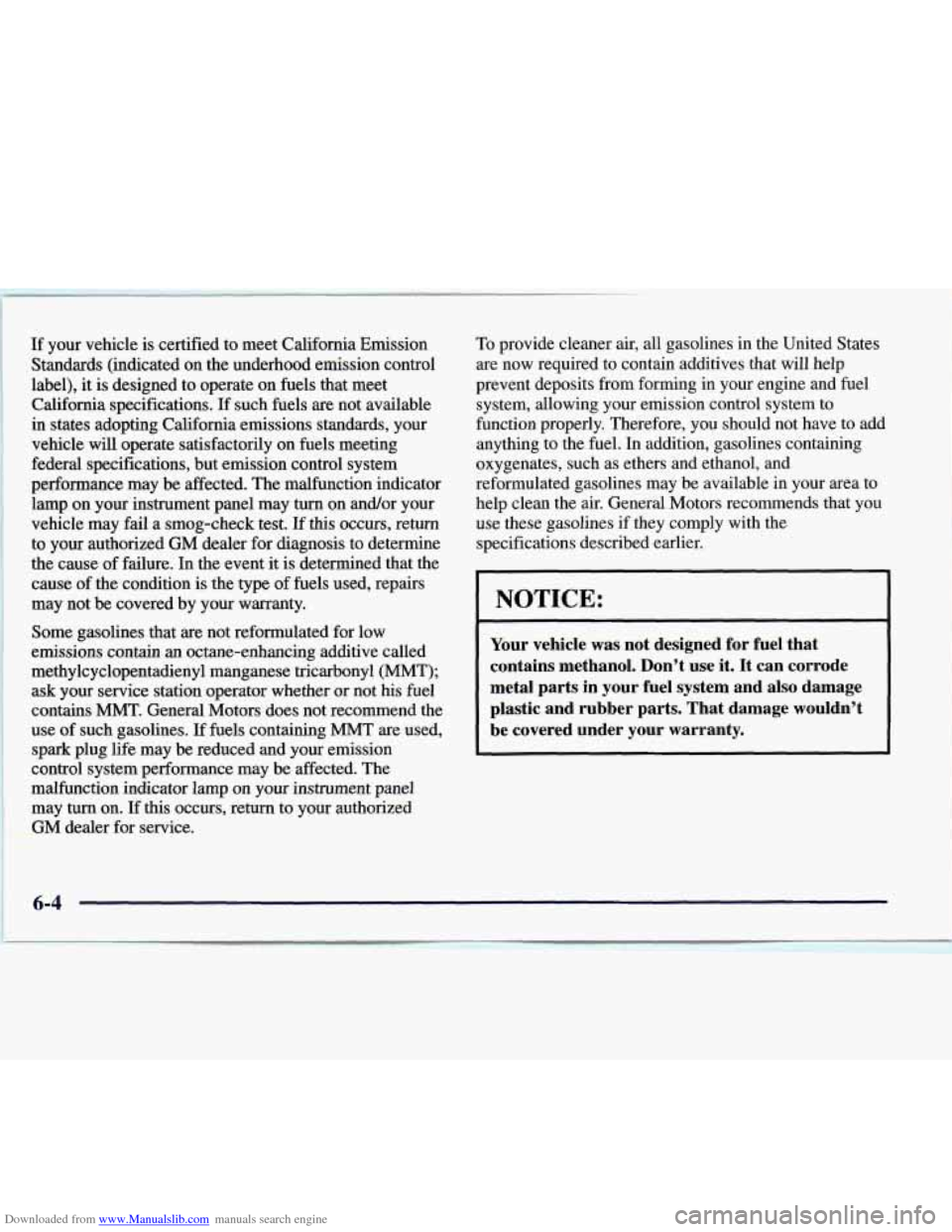
Downloaded from www.Manualslib.com manuals search engine If your vehicle is certified to meet California Emission
1 Standards (inhcated on the underhood emission control
label), it is designed to operate on fuels that meet
California specifications.
If such fuels are not available
in states adopting California emissions standards, your
vehicle
will operate satisfactorily on fuels meeting
federal specifications, but emission control system
performance may be affected. The malfunction indicator
lamp on your instrument panel may
turn on andor your
vehicle may fail a smog-check test. If this occurs,
return
to your authorized GM dealer for diagnosis to determine
the cause of failure. In the event it is. determined that the
1 cause of the condition is the type of fuels used, repairs
, may not be covered by your warranty.
Some gasolines that are not reformulated for low
emissions contain an octane-enhancing additive called
methylcyclopentadienyl manganese tricarbonyl (MMT);
ask your service station operator whether
or not his fuel
contains MMT. General Motors does not recommend the
use of such gasolines.
If fuels containing MMT are used,
~ spark plug life may be reduced and your emission
control system performance may be affected. The
malfunction indicator lamp on your instrument panel
may
turn on. If this occurs, return to your authorized
GM dealer for service.
~
i
To provide cleaner air, all gasolines in the United States
are now required to contain additives that will help
prevent deposits from forming in your engine and fuel
system, allowing your emission control system to
function properly. Therefore, you should not have to add
anything to the fuel. In addition, gasolines containing
oxygenates, such as ethers and ethanol, and
reformulated gasolines may be available in your area to
help clean the air. General Motors recommends that you
use these gasolines if they comply with the
specifications described earlier.
NOTICE:
Your vehicle was not designed for fuel that
contains methanol. Don’t .use it. It can corrode
metal parts in your fuel system and also damage
plastic and rubber parts. That damage wouldn’t
be covered under your warranty.
6-4
I
Page 269 of 386
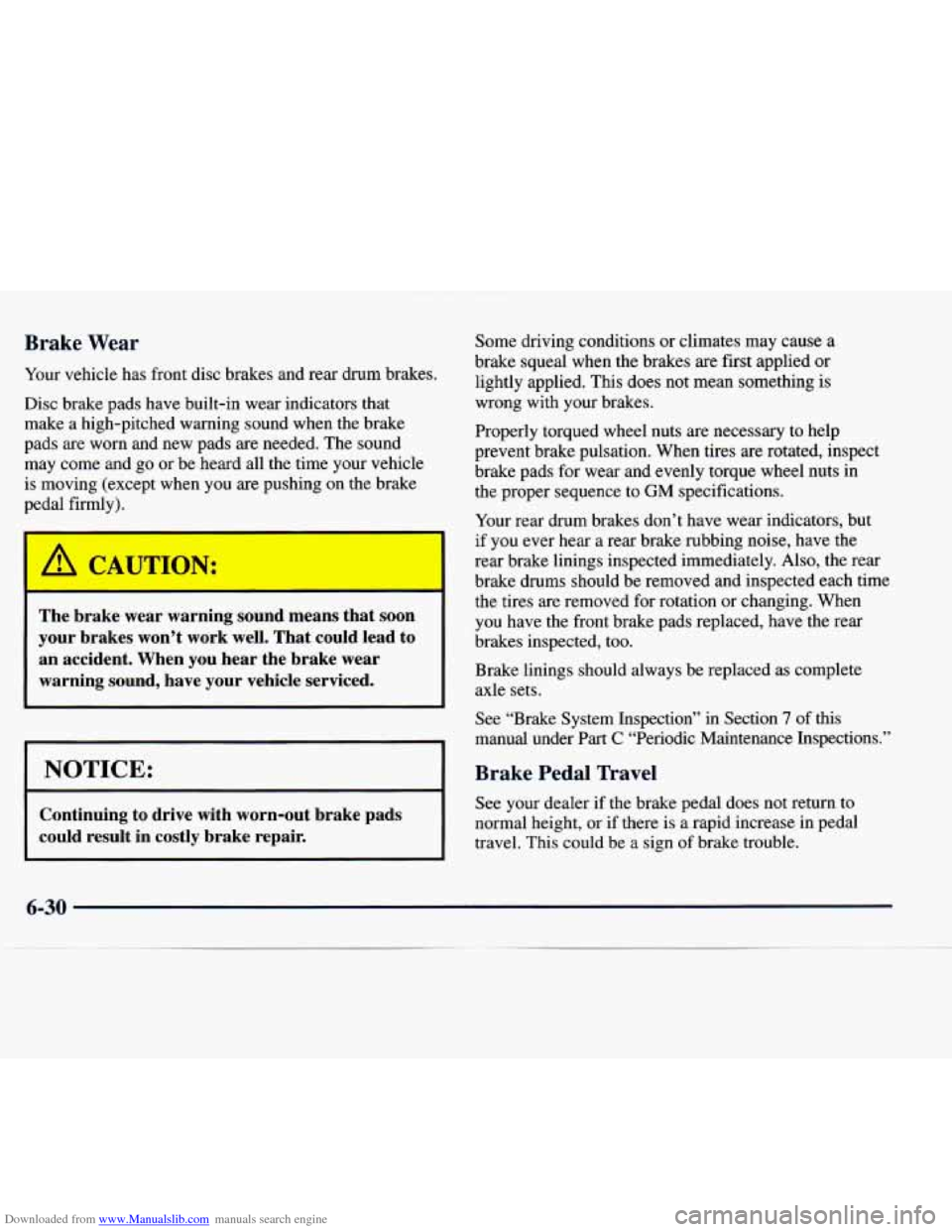
Downloaded from www.Manualslib.com manuals search engine Brake Wear
Your vehicle has front disc brakes and rear drum brakes.
Disc brake pads have built-in wear indicators that
make
a high-pitched warning sound when the brake
pads are worn and new pads are needed. The sound
may come and go or be heard all the time your vehicle
is moving (except when you
are pushing on the brake
pedal firmly).
r
I
The brake wear warning sound means that soon
your brakes won’t work well. That could lead to
an accident. When you hear the brake wear
warning sound, have your vehicle serviced.
I NOTICE:
Continuing to drive with worn-out brake pads
could result in costly brake repair.
Some driving conditions or climates may cause a
brake squeal when the brakes are first applied or
lightly applied. This does not mean something is
wrong with your brakes.
Properly torqued wheel nuts are necessary to help
prevent brake pulsation. When tires
are rotated, inspect
brake pads for wear and evenly torque wheel nuts in
the proper sequence
to GM specifications.
Your rear drum brakes don’t have wear indicators, but
if you ever hear a rear brake rubbing noise, have the
rear brake linings inspected immediately. Also, the rear
brake drums should be removed and inspected each time
the tires are removed for rotation or changing. When
you have the front brake pads replaced, have the rear
brakes inspected, too.
Brake linings should always be replaced as complete
axle sets.
See “Brake System Inspection’’ in Section
7 of this
manual under Part
C “Periodic Maintenance Inspections.’’
Brake Pedal Travel
See your dealer if the brake pedal does not return to
normal height, or if there
is a rapid increase in pedal
travel.
This could be a sign of brake trouble.
Page 379 of 386
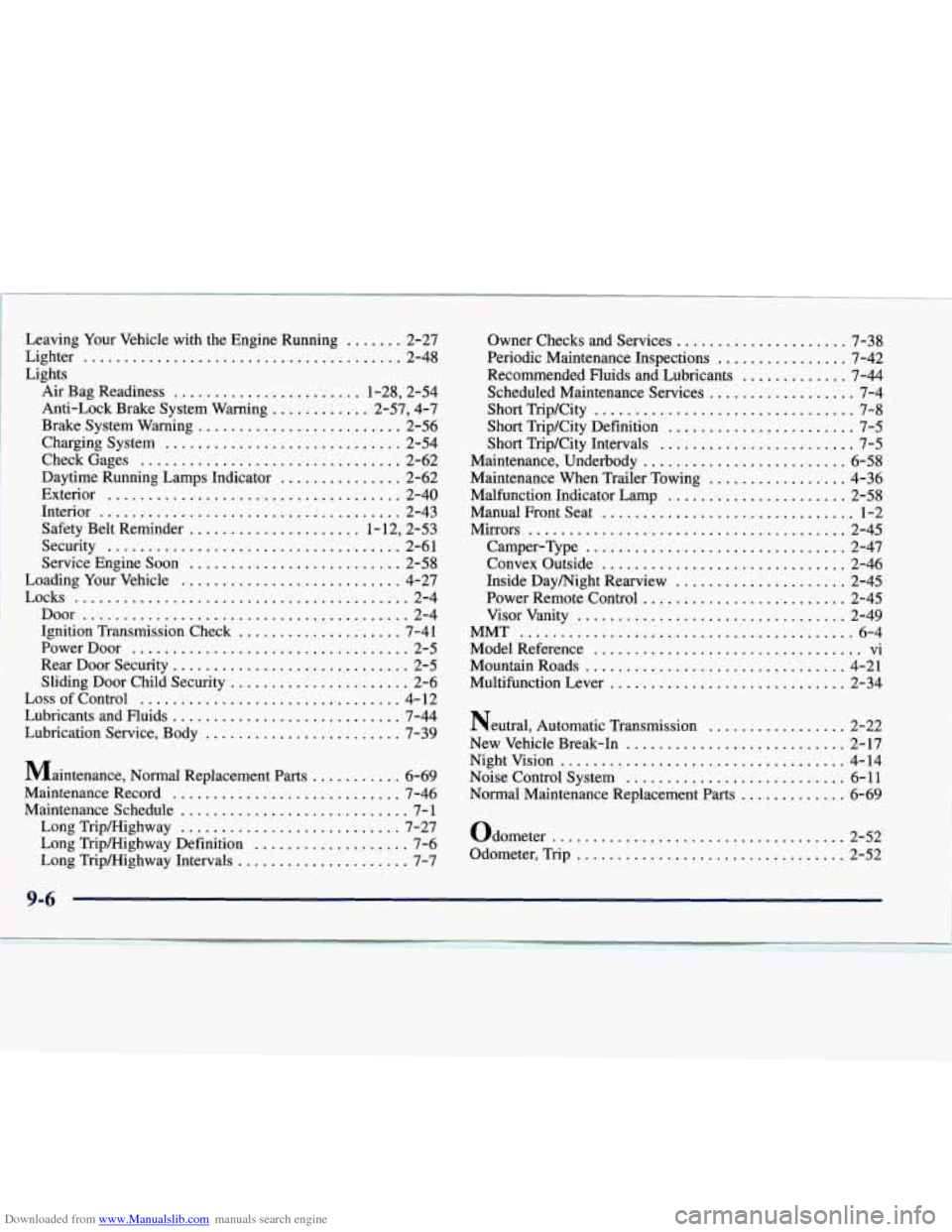
Downloaded from www.Manualslib.com manuals search engine Leaving Your Vehicle with the Engine Running ....... 2-27
Lighter
........................................ 2-48
Lights Air Bag Readiness
....................... 1-28, 2-54
Anti-Lock Brake System Warning
............ 2-57, 4-7
Brake System Warning
......................... 2-56
Charging System
............................. 2-54
Daytime Running Lamps Indicator
............... 2-62
Safety Belt Reminder
..................... 1- 12, 2-53
Security
.................................... 2-61
Service Engine Soon
.......................... 2-58
Loading Your Vehicle
........................... 4-27
Ignition Transmission Check
.................... 7-41
Sliding Door Child Security ...................... 2-6
Lubricants and Fluids
............................ 7-44
Lubrication Service, Body
........................ 7-39
CheckGages
................................ 2-62
Exterior
.................................... 2-40
Interior
..................................... 2-43
Locks
......................................... 2-4
Door
........................................ 2-4
PowerDoor
.................................. 2-5
RearDoorSecu
rity ............................. 2-5
LossofControl
................................ 4-12
Maintenance. Normal Replacement parts
........... 6-69
Maintenance Record
............................ 7-46
Maintenance Schedule
............................ 7-1
Long Tripmighway
........................... 7-27
Long Tripmighway Definition
................... 7-6
Long Tripmighway Intervals
..................... 7-7
Owner Checks and Services ..................... 7-38
Periodic Maintenance Inspections
................ 7-42
Recommended Fluids and Lubricants
............. 7-44
Scheduled Maintenance Services
.................. 7-4
Short Trip/City
................................ 7-8
Short Trip/City Definition ....................... 7-5
Short Trip/City Intervals
........................ 7-5
Maintenance. Underbody
......................... 6-58
Maintenance When Trailer Towing
................. 4-36
Malfunction Indicator Lamp
...................... 2-58
Camper-Type
................................ 2-47
Convex Outside
.............................. 2-46
Inside Daymight Rearview
..................... 2-45
Power Remote Control
......................... 2-45
Model Reference
................................. vi
MountainRoads
................................ 4-21
Multifunction Lever
............................. 2-34
ManualFrontSeat
........,...................... l-2
Mirrors ....................................... 2-45
Visorvanity
................................. 2-49
MMT ......................................... 6-4
Neutral. Automatic Transmission ................. 2-22
New Vehicle Break-In
........................... 2-17
Nightvision
................................... 4-14
Noise Control System
........................... 6-11
Normal Maintenance Replacement
Parts ............. 6-69
Odometer
.................................... 2-52
Odometer. Trip
................................. 2-52
9-6
Page 382 of 386

Downloaded from www.Manualslib.com manuals search engine Service and Appearance Care ...................... 6-1
Service and Owner Publications .............. 8- 11. 8- 12
Service Publications
........................ 8- 1 1. 8. 12
Servicing Your Air Bag-Equipped Vehicle
........... 1-32
Sheet Metal Damage
............................ 6-57
ShiftLever
............................... 2.21. 2.25
Shifting
Automatic Transmission
....................... 2-21
Into Park (P)
................................. 2-25
OutofPark
.................................. 2-28
Shoulder Belt Height Adjuster
..................... 1 . 19
Sidemarker Lamp Bulb Replacement
............... 6-36
SignalingTurns
................................ 2-35
Specifications and Capacities
...................... 6-67
Speech Impaired. Customer Assistance
............... 8-4
Speedometer
................................... 2-52
Stains. Cleaning
................................ 6-52
Starter Switch Check
............................ 7-40
Starting Your Engine
............................ 2- 18
Steam
........................................ 5-12
Steering
....................................... 4-8
In Emergencies
............................... 4-10
Power
....................................... 4-8
Speed Sensitive
............................... 4-9
Tips
......................................... 4-9
Wheel. Tilt
.................................. 2-34
StorageAreas
.................................. 2-48
Storage. Vehicle
................................ 6-3 1
Stuck: In Sand. Mud. Ice or Snow .................. 5-36
SunVisors .................................... 2-49
Symbols. Vehicle
.................................. v
Skidding ...................................... 4-13 Taillamp
Bulb Replacement
...................... 6-37
TapePlayerCare
............................... 3-25
Temperature Control. Rear Passenger
................ 3-5
Theft ......................................... 2-15
Theft-Deterrent Feature
.......................... 3-21
Thermostat
.................................... 6-25
Third Gear. Automatic Transmission
................ 2-23
Tilt Steering Wheel
............................. 2-34
Time. Setting the
................................ 3-7
Tirechains
.................................... 6-50
TireLoading ................................... 4-27
Tire-Loading Information Label
................... 4-27
Tires
......................................... 6-41
Alignment and Balance
........................ 6-48
BuyingNew
................................. 6-46
Chains
..................................... 6-50
ChangingaFlat
.............................. 5-22
Cleaning
.................................... 6-57
Dual Operation
............................... 6-45
Inflation
.................................... 6-42
Inflation Check
............................... 7-38
Inspection and Rotation
........................ 6-43
Loading
.................................... 4-27
Pressure
.................................... 6-42
Temperature
................................. 6-48
Traction
.................................... 6-48
Treadwear
................................... 6-47
Uniform Quality Grading
....................... 6-47
Wear Indicators
.............................. 6-45
Wheel Replacement
........................... 6-49
When It’s Time for New
....................... 6-45
TopStrap
..................................... 1-51